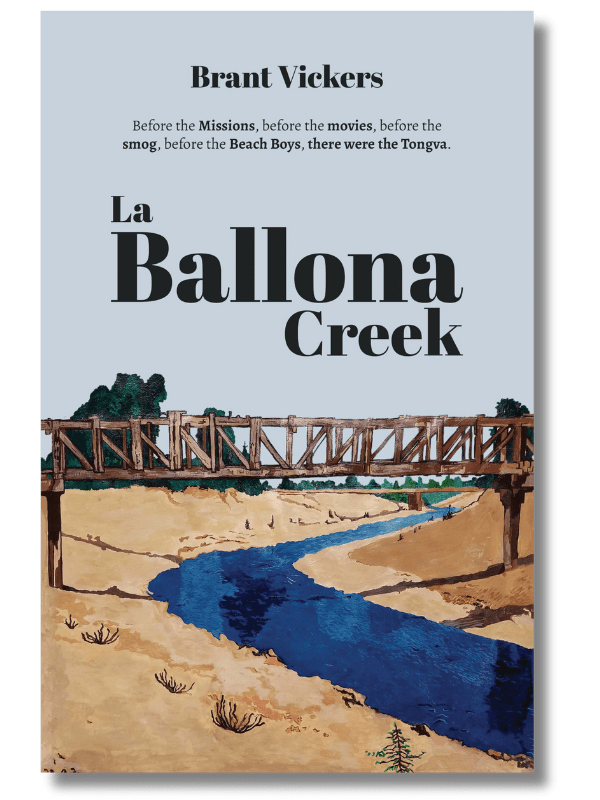
La Ballona Creek
by Brant Vickers
Genre: Young Adult / Paranormal / Historical
ISBN: 9798891324534
Print Length: 246 pages
Publisher: Atmosphere Press
Reviewed by Lauren Hayataka
In the margins of memory and loss, three boys learn what it means to remember.
In La Ballona Creek, Brant Vickers delivers a quietly devastating novel about three boys drifting through grief, clinging to the banks of forgotten history that the world refuses to remember.
Set in 1970s Culver City, this young adult novel is a time-traveling, genre-defying story that weaves together magical realism, Native history, and the emotional landscape of lost boys on the cusp of becoming something more.
Fifteen-year-old Jorma Nevala has never quite recovered from his mother’s death and his father’s abandonment. Raised by a permissive grandfather, Jorma finds his makeshift family in two brothers, Yogi and Sonny, who are just as untethered by grief and neglect. The trio scrounges out joy in blues records, filthy basements, and the murky expanse of La Ballona Creek—a cemented river basin both feared and sacred, a place that, like them, is overlooked and misunderstood. But it’s not just a refuge. It’s a passageway.
When Sonny disappears underground, first beneath his house and then into the sewer systems of Culver City, Jorma and Yogi follow him to a backyard trench and into the company of a reclusive shaman named Tomer. What begins as a search for their friend becomes a reckoning: with what was taken, what was buried, and what remains. Tomer is determined to preserve the memory of his ancestors, even as construction companies unearth and discard Tongva graves to make room for movie studios and luxury homes.
Tomer teaches the boys the difference between embracing a culture and adopting it. Vickers handles this with care—making it clear that the boys, who are not Native, are not “playing Indian.” Instead, they are listening, learning, and grieving in tandem with a people whose very existence has been written over. “You will never be Tongva,” Tomer warns them. “But you can take from it the things that make you better.”
There’s a gentle power in how Vickers constructs each boy: Yogi, whose athleticism is inherited but unwanted; Sonny, a selective mute at school but fluent in multiple languages, digging tunnels beneath his house and scavenging for facts and figures; and Jorma, the narrator, who floats unmoored by loss and by the feeling that he might disappear at any moment. Their friendship feels lived-in, believable in its love and its silences. There’s no sentimentality here. Just rawness. Just truth.
Midway through the novel, the boys are swept—literally and figuratively—into the past, where they encounter the Tongva people as they clash with Spanish missionaries. Here, the novel leans harder into its speculative elements, and while the emotional threads remain intact, the pacing begins to slow. The narrative sometimes meanders in this second half, particularly as the urgency of the present day gives way to a more reflective tone. Although these sections are still thoughtfully crafted, the novel feels most grounded—and most affecting—when it has both feet planted firmly in the California of 1970.
What makes La Ballona Creek so devastating is that there is no catharsis, only clarity. The novel is about how identity can be erased—intentionally, systemically—and how those left behind are forced to live among the ruins. Tomer says the bones unearthed by developers were boxed up and stored in trailers. “Our graves,” he says, “are considered archaeological sites, not cemeteries.” That distinction defines every page.
And yet, there’s hope. The boys are not healed, but they are changed. The past does not give them closeness; it gives them perspective. As the novel approaches its conclusion, it doesn’t chase a tidy resolution. Instead, it lingers in the quiet ache of what’s been lost and the fragile power of what can still be remembered. Vickers doesn’t pretend that understanding the past can undo harm—but he shows, with care, that remembrance can reshape how we move forward. Even in the face of cultural erasure and personal grief, perspective can be transformative. It is transformative.
For all its genre-bending structure, what lingers most are the human moments: a shaman teaching a boy how to run, two boys missing their brother, and three kids daring to believe that they belong somewhere. Vickers writes with reverence for the invisible—the people and places history tried to forget—and gives them a voice that feels unmistakably alive.
Thank you for reading Lauren Hayataka’s book review of La Ballona Creek by Brant Vickers! If you liked what you read, please spend some more time with us at the links below.


0 comments on “Book Review: La Ballona Creek”